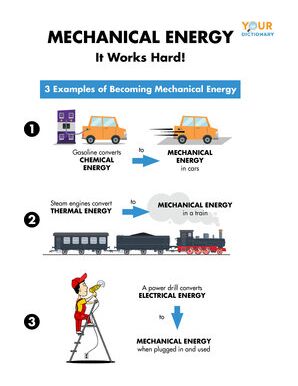

Mechanical energy, also known as motion energy, is how an object moves based on its position and motion. It occurs when a force acts upon an object and the object uses the transferred energy as movement. If an object is moving, it is using mechanical energy. Review the examples of mechanical energy below for where you can see it in your everyday life.
Everyday Examples of Mechanical Energy
Mechanical energy is one of the only types of energy that is easy to see. If something is moving, it is using mechanical energy! Take a look at these sources of mechanical energy that you’re likely to find in the home.
- Turning a doorknob
- Breathing in and out
- Hammering a nail
- Riding a bicycle
- Sharpening a pencil
- Using kitchen appliances
- Listening to music
- Typing on a keyboard
- Driving a car
- Exercising
Take a look around you. Any object that is moving is using kinetic mechanical energy. Even objects that are not moving are storing potential mechanical energy. When you move something with your hand, you’ve transferred kinetic mechanical energy from your body to the object you are moving.
Potential vs. Kinetic Mechanical Energy
There are two types of mechanical energy: potential energy (stored energy of position) and kinetic energy (energy of motion). The mechanical energy of an object is the sum of its potential energy and its kinetic energy. Objects with higher amounts of mechanical energy will move more than objects with low mechanical energy.
Potential Mechanical Energy
When an object is able to move but does not have a force working upon it, it is storing potential mechanical energy. The two main types of potential energy are:
- Gravitational Potential Energy: Energy that is stored in the height or position of an object. Heavier objects possess higher amounts of gravitational energy.
- Elastic Potential Energy: Energy that is stored by virtue of an object’s condition. This condition often depends on the object’s material (such as rubber).
For example, a heavy bowling ball held four feet above the ground has more gravitational potential energy than a lighter tennis ball, which has some elastic potential energy because of its rubber material.
When a force acts upon the balls to drop them, the gravitational potential energy of the bowling ball combines with its kinetic energy of motion. It will drop with more force than the tennis ball, which will bounce due to its high elastic potential energy.
Kinetic Mechanical Energy
An object uses kinetic mechanical energy when it is currently moving. A force has acted upon the object, causing it to do work. Kinetic mechanical energy can occur when another object’s kinetic energy transfers to it (such as when a pitcher throws a ball), or when another type of kinetic energy converts to mechanical energy.
In addition to mechanical energy, the four types of kinetic energy include:
- Radiant Energy: Energy produced by light waves
- Electrical Energy: Energy produced by electricity
- Sound Energy: Energy produced by sound waves
- Thermal Energy: Energy produced by heat
No form of energy can be created or destroyed. Energy can only be transferred or converted into different types of energy.
Mechanical Energy Conversions
Any transferred energy that causes an object to do work is an example of energy conversion. Conversions to mechanical energy allow an object to move.
Becoming Mechanical Energy
Here are some examples of ways that different types of energy become mechanical energy.
- Gasoline converts chemical energy to mechanical energy in cars.
- Steam engines convert thermal energy into mechanical energy in a train.
- Your body converts chemical energy from nutrients to mechanical energy for movement.
- A power drill converts electrical energy to mechanical energy when plugged in and used.
- Music converts sound energy to mechanical energy in your eardrum.
Converting Mechanical Energy
Conversely, mechanical energy can convert into different types of energy. Check out these examples of energy transformation from movement.
- Windmills convert mechanical energy to electrical energy in homes.
- Hitting a drum converts mechanical energy to sound energy.
- Rubbing your hands together converts mechanical energy to thermal energy.
- Turning on a light switch converts mechanical energy to electrical and radiant energy.
-
Digesting food converts mechanical energy to chemical energy.

Additional Physics Resources
Continue the instruction with more articles on physics concepts. Check out these examples of objects in a state of inertia, or a list of physical properties of matter or energy. No matter what you do, keep moving!